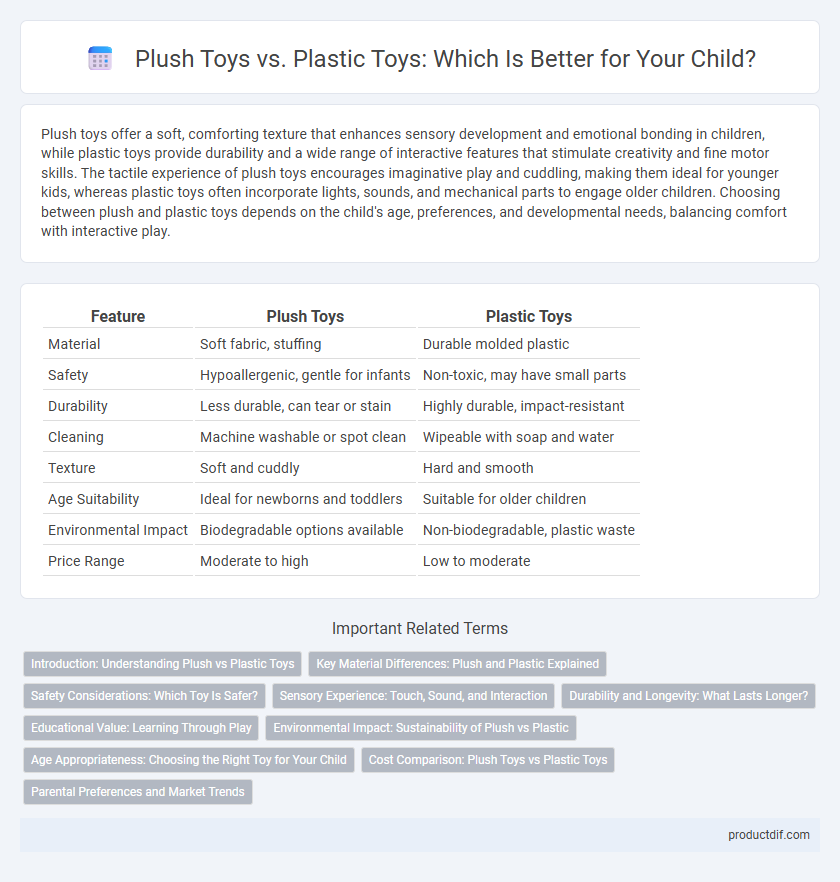Plush toys offer a soft, comforting texture that enhances sensory development and emotional bonding in children, while plastic toys provide durability and a wide range of interactive features that stimulate creativity and fine motor skills. The tactile experience of plush toys encourages imaginative play and cuddling, making them ideal for younger kids, whereas plastic toys often incorporate lights, sounds, and mechanical parts to engage older children. Choosing between plush and plastic toys depends on the child's age, preferences, and developmental needs, balancing comfort with interactive play.
Table of Comparison
| Feature | Plush Toys | Plastic Toys |
|---|---|---|
| Material | Soft fabric, stuffing | Durable molded plastic |
| Safety | Hypoallergenic, gentle for infants | Non-toxic, may have small parts |
| Durability | Less durable, can tear or stain | Highly durable, impact-resistant |
| Cleaning | Machine washable or spot clean | Wipeable with soap and water |
| Texture | Soft and cuddly | Hard and smooth |
| Age Suitability | Ideal for newborns and toddlers | Suitable for older children |
| Environmental Impact | Biodegradable options available | Non-biodegradable, plastic waste |
| Price Range | Moderate to high | Low to moderate |
Introduction: Understanding Plush vs Plastic Toys
Plush toys are crafted from soft fabrics filled with stuffing, offering a tactile and comforting experience, while plastic toys are molded from durable polymers, providing rigidity and detailed designs. The choice between plush and plastic toys often depends on factors like safety, durability, sensory engagement, and developmental benefits for children. Understanding the distinct materials and play value helps caregivers select appropriate toys that support emotional comfort or imaginative play.
Key Material Differences: Plush and Plastic Explained
Plush toys are primarily made from soft fabrics like polyester, cotton, and stuffed with materials such as polyester fiberfill, providing a cuddly texture ideal for comfort and sensory play. Plastic toys are constructed from various polymers like ABS or PVC, offering durability, rigidity, and the ability to form detailed shapes with vibrant colors. The key material differences impact safety, tactile experience, and longevity, with plush toys favored for softness and plastic toys valued for structural resilience.
Safety Considerations: Which Toy Is Safer?
Plush toys generally offer enhanced safety due to their soft, non-toxic materials that reduce choking hazards and minimize injury risks for young children. In contrast, plastic toys can contain small parts and harmful chemicals like BPA or phthalates, which pose ingestion and toxicity concerns, especially in toddlers. Selecting toys compliant with safety standards such as ASTM F963 or EN71 ensures reduced exposure to hazardous substances regardless of material type.
Sensory Experience: Touch, Sound, and Interaction
Plush toys offer a soft, tactile experience with materials like cotton and polyester, providing comforting textures that engage touch and promote sensory development. Plastic toys often incorporate interactive elements such as buttons or sounds, delivering auditory stimulation and encouraging fine motor skills through manipulation. The choice between plush and plastic toys impacts sensory engagement, where plush emphasizes warmth and softness, while plastic focuses on sound and dynamic interaction.
Durability and Longevity: What Lasts Longer?
Plush toys offer softness and comfort but generally show signs of wear faster than plastic toys due to fabric susceptibility to tears and stains. Plastic toys, often made from durable polymers, resist impact and environmental damage, providing longer-lasting playtime without significant degradation. High-quality plastic toys maintain structural integrity over years, making them a preferred choice for durability and longevity in children's playthings.
Educational Value: Learning Through Play
Plush toys enhance emotional learning and sensory development by encouraging imaginative role-play and nurturing behaviors in children. Plastic toys often incorporate interactive elements like buttons or puzzles that promote cognitive skills such as problem-solving, spatial awareness, and fine motor coordination. Both types of toys contribute uniquely to early childhood education by fostering creativity and critical thinking through hands-on play experiences.
Environmental Impact: Sustainability of Plush vs Plastic
Plush toys, often made from biodegradable materials like cotton and wool, generally have a lower environmental impact compared to plastic toys, which are derived from non-renewable petroleum and contribute significantly to landfill waste and ocean pollution. The production of plastic toys involves high energy consumption and releases harmful greenhouse gases, whereas sustainable plush toys can be crafted using recycled or organic fabrics, reducing their carbon footprint. Proper disposal or recycling of plush toys further minimizes environmental harm, highlighting the importance of choosing eco-friendly plush alternatives for sustainability.
Age Appropriateness: Choosing the Right Toy for Your Child
Plush toys are ideal for infants and toddlers due to their soft texture and safety, reducing choking hazards and promoting tactile development. Plastic toys offer durability and are suitable for older children who can handle more complex shapes and interactive features without risk of injury. Selecting toys based on age appropriateness ensures a safe play environment and supports developmental milestones effectively.
Cost Comparison: Plush Toys vs Plastic Toys
Plush toys generally cost more than plastic toys due to the materials and labor involved in sewing and stuffing fabric, with average prices ranging from $10 to $30 compared to $5 to $20 for plastic counterparts. Plastic toys benefit from mass production and mold replication, significantly lowering manufacturing expenses and retail prices. However, the long-term durability of plastic toys may reduce replacement frequency, potentially making them more cost-effective for budget-conscious buyers.
Parental Preferences and Market Trends
Parental preferences increasingly favor plush toys for their safety, softness, and comfort, making them ideal for infants and toddlers. Market trends show a rising demand for eco-friendly and hypoallergenic plush options, reflecting growing concerns about plastic toxicity and environmental impact. Despite plastic toys' durability and interactive features, plush toys dominate in early childhood segments due to parental emphasis on nurturing and sensory development.
Plush toys vs plastic toys Infographic

 productdif.com
productdif.com